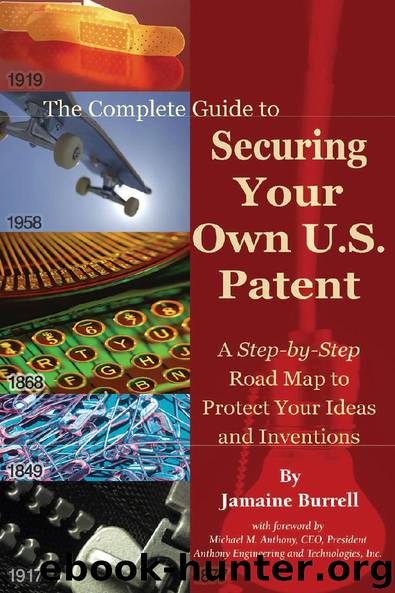The Complete Guide To Securing Your Own U.S. Patent by Jamaine Burrell

Author:Jamaine Burrell
Language: eng
Format: epub
Publisher: Atlantic Publishing
Published: 2013-06-17T00:00:00+00:00
Non-Provisional Patent Applications
All non-provisional patent applications must be filed as written documents, inclusive of a specification and an oath or declaration. The specification includes a description of the invention and claims that define the scope of the invention. The application must also include drawings, when necessitated, and the appropriate filling fees. All documentation must be provided in English or in a verified translation of documents into English. Documents must be legibly typewritten or printed using dark permanent ink and portrait orientation on durable, non-glossy white paper. All pages of the document should be the same size, A4 or 8½ x 11 inches, with top and bottom margins of at least ¾ inch, a right margin of at least ¾ inch and a left margin of at least one inch. Page spacing should be either double-spaced or 11⁄2 spacing. They should be consecutively numbered, with page numbers visibly centered either above or below the text, starting with page one. Document fonts and content should be sufficiently dark to be capable of reproduction.
A patent application is not considered complete until all required components of the application are complete and in compliance with established rules. Incomplete patent applications are not forwarded for examination. Instead, the PTO will notify the applicant of the deficiency and be given a time to bring the application within compliance. The PTO may include a surcharge for a new submission to an application. If the deficiencies are not corrected within the required time, the application will either be returned to the applicant or disposed of. The filling fee will be refunded to the applicant less a handling fee, as published in the PTO’s schedule of fees.
The filing date of a non-provisional patent application will be documented as the date on which the PTO receives a complete and compliant application. All complete applications received at the PTO are numbered in serial order and the applicant is provided a filing receipt that indicates the serial number and filling date of the patent application. Applicants are advised to submit all components of an application as one complete application. If an incomplete application is supplemented by additional and requested components, each component must be signed by the applicant with a letter that clearly and accurately connects the additional components with the existing components of the application.
Patent laws require that all non-provisional patent applications include an oath or declaration. An oath declares that the inventor making application for a patent believes that he or she is truly the original or first inventor of the subject matter of the application. An oath commits the inventor to certain other allegations as required by law and/or the PTO. The oath must be sworn and signed before a notary public or other person designated to administer such oaths. A declaration may be used in lieu of an oath under certain circumstances as follows:
• When reissuing patents.
• When claiming matter originally described, but not originally claimed.
• When filing a divisional or continuing application.
Download
This site does not store any files on its server. We only index and link to content provided by other sites. Please contact the content providers to delete copyright contents if any and email us, we'll remove relevant links or contents immediately.
Killers of the Flower Moon by David Grann(3761)
Machine Learning at Scale with H2O by Gregory Keys | David Whiting(3663)
Oathbringer (The Stormlight Archive, Book 3) by Brandon Sanderson(2660)
Will by Will Smith(2595)
Once Upon a Broken Heart by Stephanie Garber(2537)
Guns, Germs and Steel by Diamond Jared(2206)
Borders by unknow(2122)
It Starts With Us (It Ends with Us #2) by Colleen Hoover(2059)
The Room Where It Happened by John Bolton;(2036)
Friends, Lovers, and the Big Terrible Thing by Matthew Perry(2018)
The Color of Law by Richard Rothstein(1824)
HBR's 10 Must Reads 2022 by Harvard Business Review(1703)
The Strength In Our Scars by Bianca Sparacino(1702)
A Short History of War by Jeremy Black(1679)
Water Rights and the Environment in the United States by John Burch(1607)
Examples & Explanations: Administrative Law by William F. Funk & Richard H. Seamon(1555)
515945210 by Unknown(1525)
Pharmacy Practice and The Law by Richard Abood(1497)
That Every Man Be Armed by Stephen P. Halbrook(1481)
